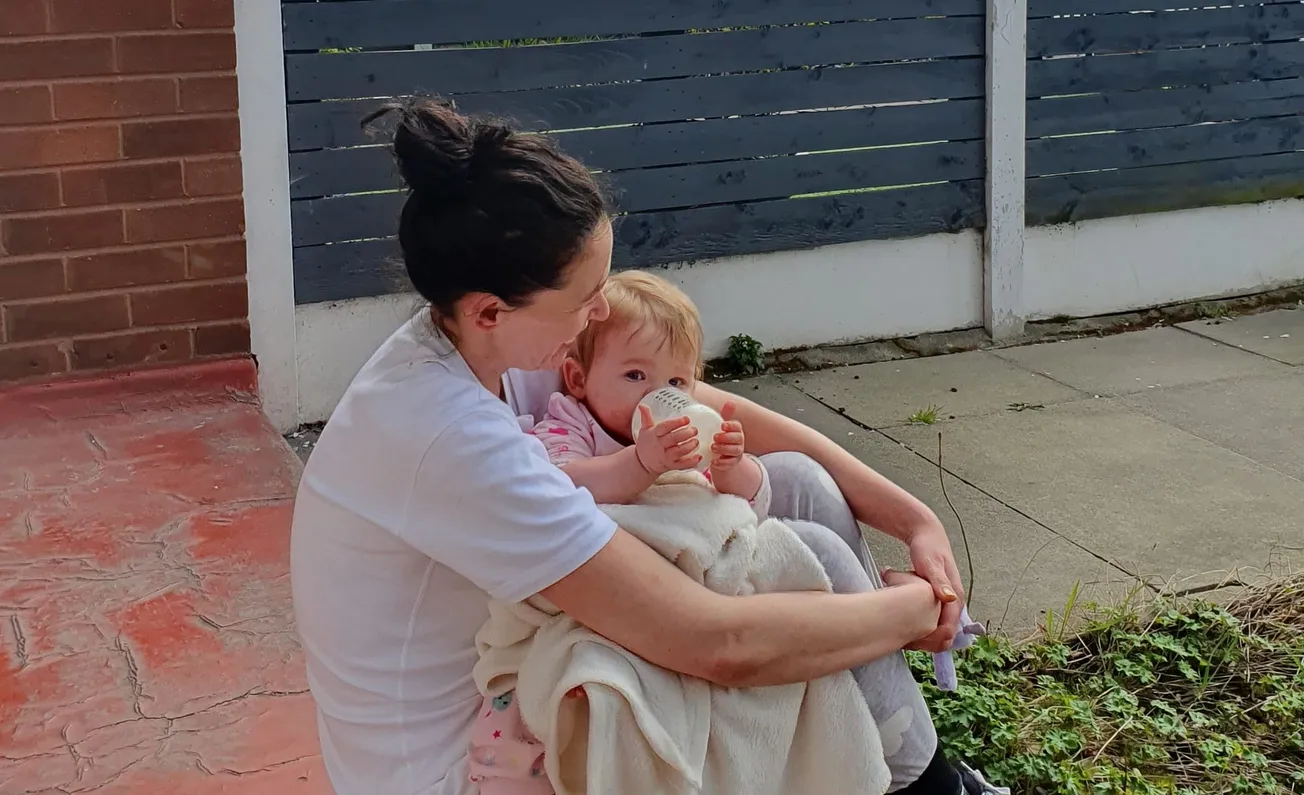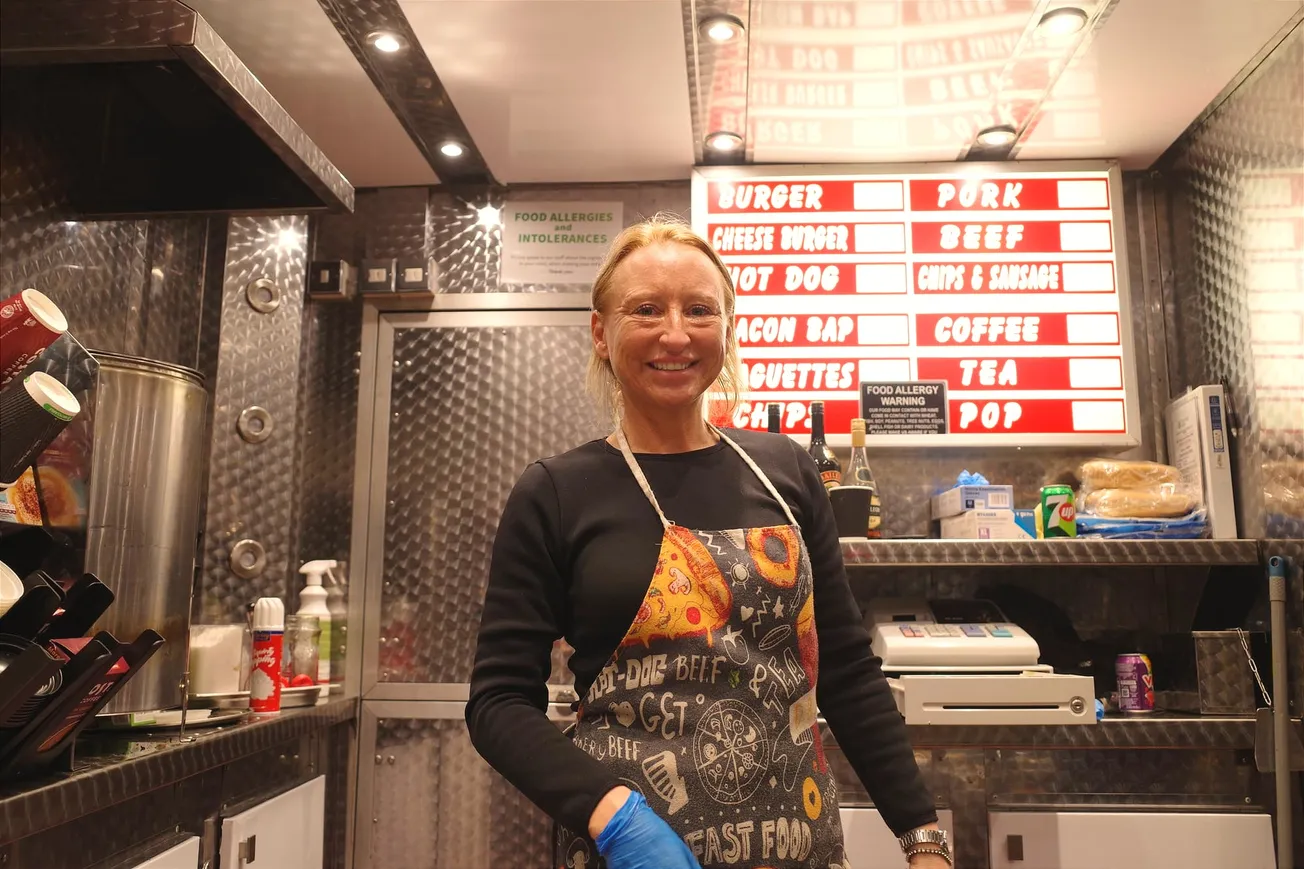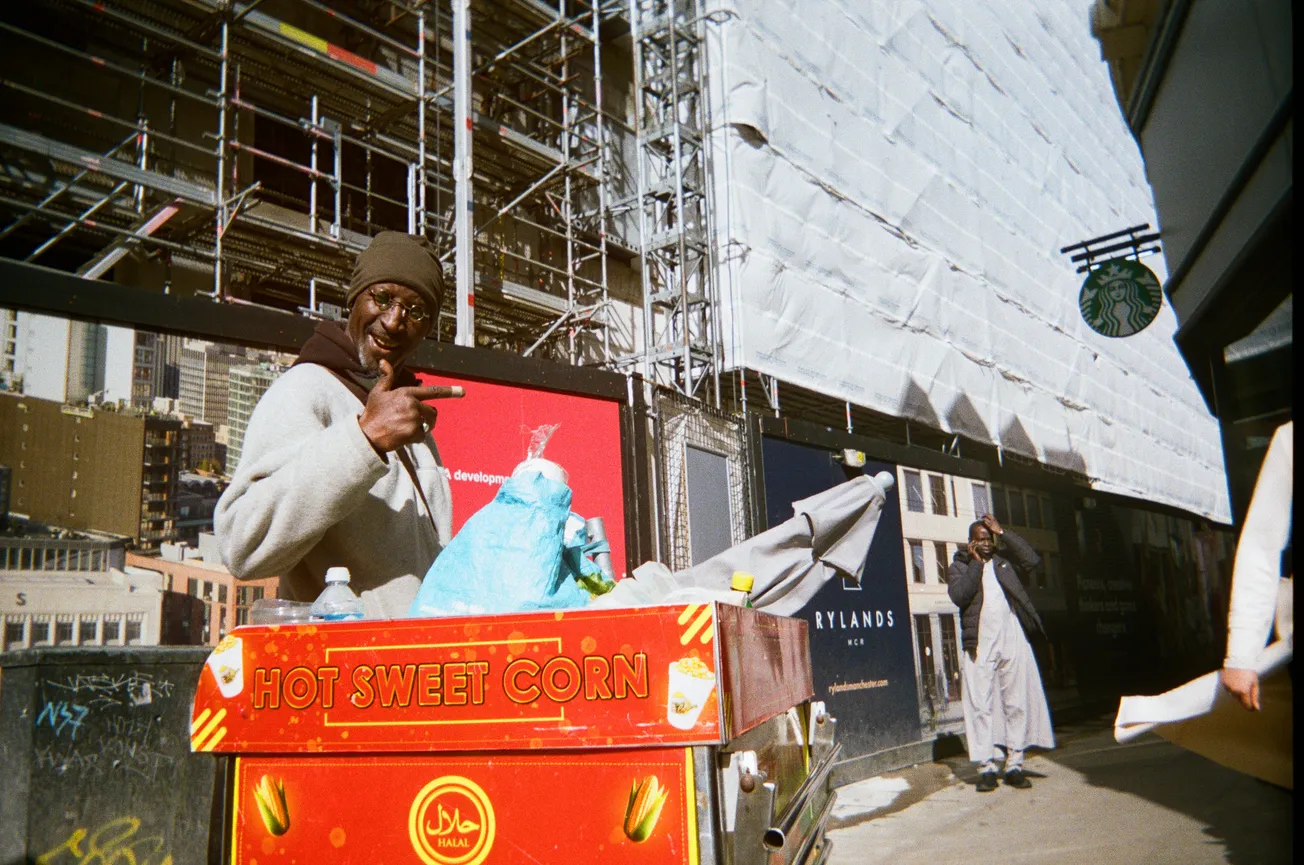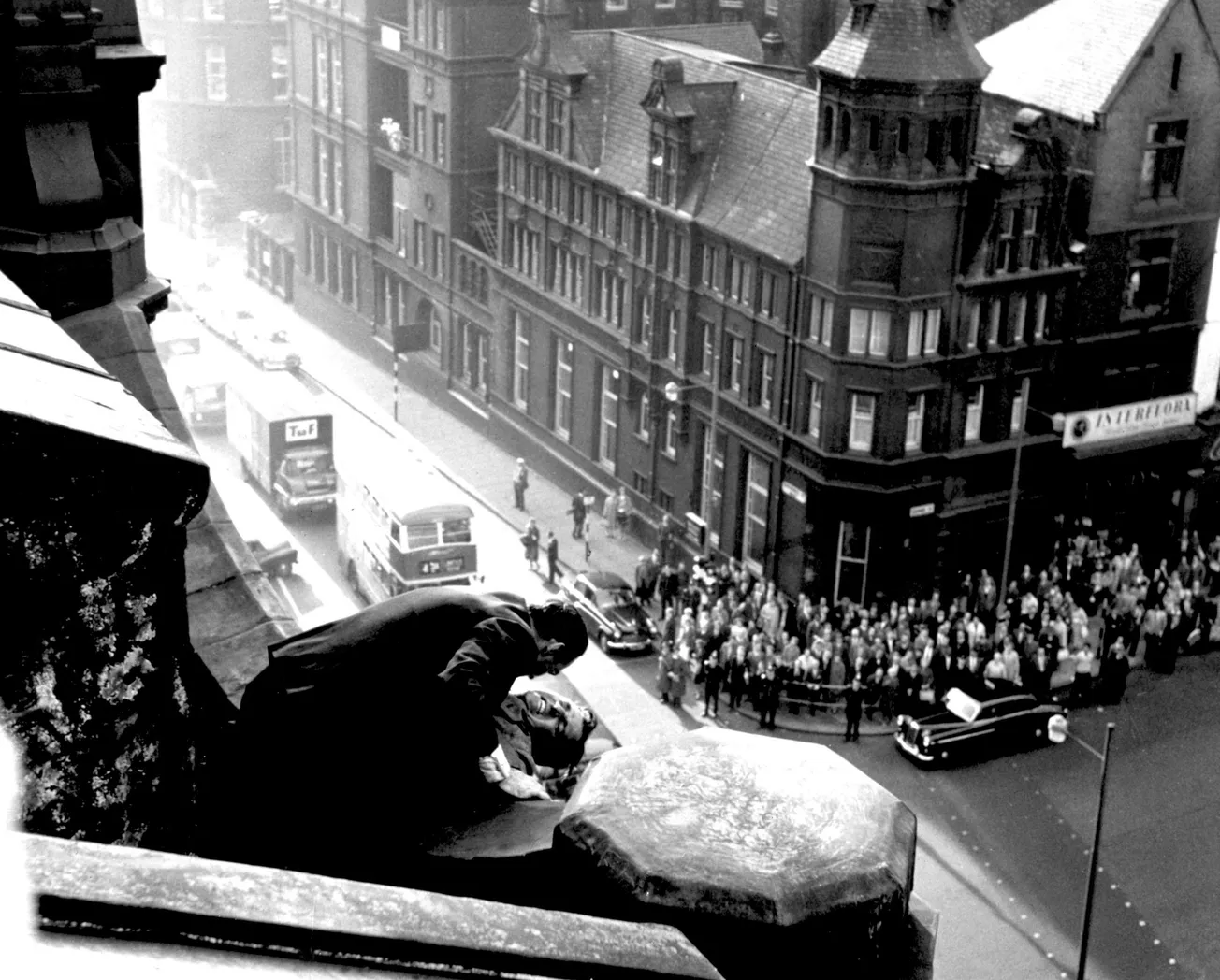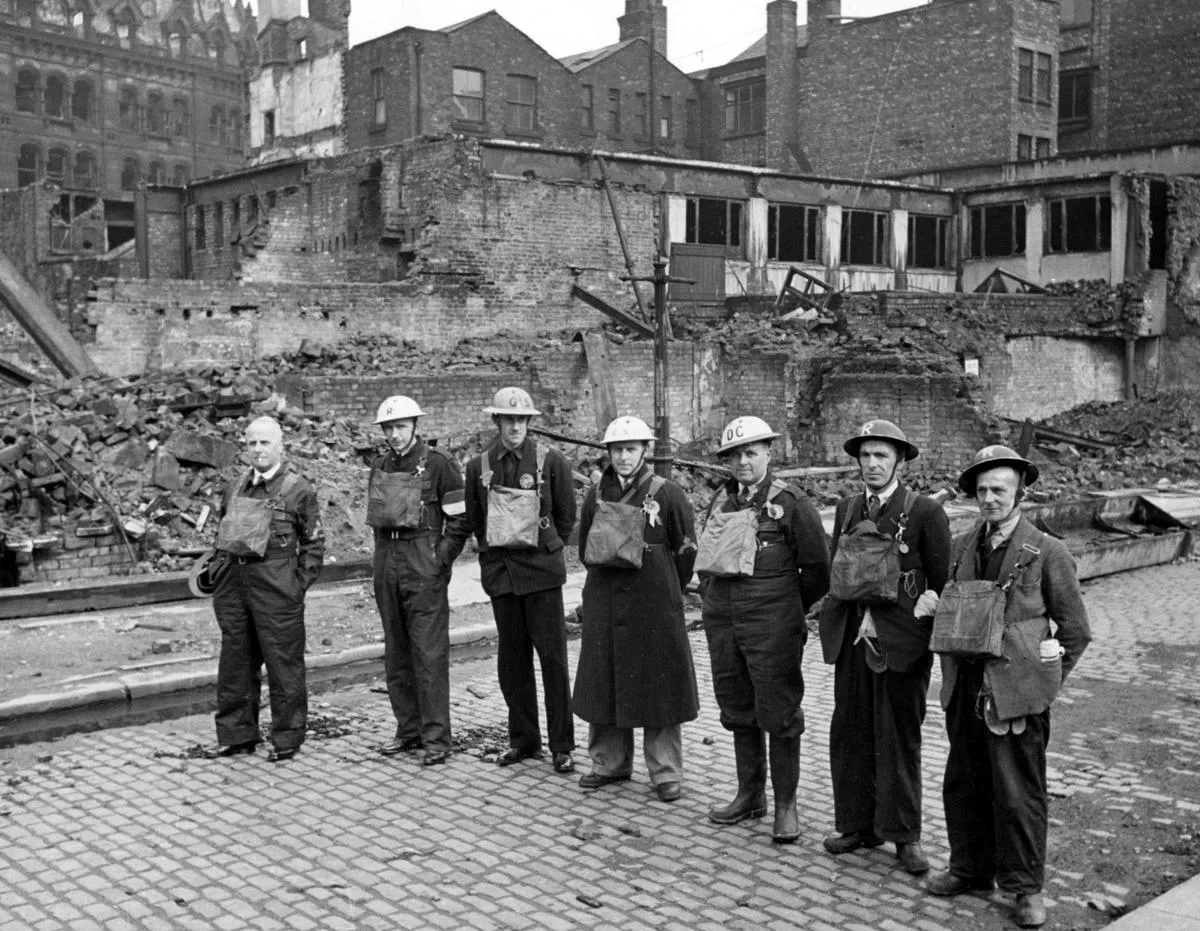It was in late June 2021, on a balmy summer’s evening when residents were chatting over the walls in their small front gardens, that I first heard about the Ancoats war. I had been wandering along Old Mill Street, the thoroughfare that snakes past New Islington Marina and points you up into Miles Platting and the hinterlands of East Manchester, parallel to the Ashton Canal. It had been a warm month and some of the cherry trees in the front gardens of the two storey 1970s houses had retained tiny white blossoms from the Spring.
Slightly further up the road, I spoke to two sisters, Nicola and Cyranne – long time residents of the area and next-door neighbours. Their mum lives two doors down and their grandparents lived in the same row of council houses too. We got talking about Brunswick Mill, the vast brick edifice that faces their houses and was once one of Britain’s largest cotton spinning mills.
A major redevelopment had recently been announced and the sisters were apprehensive about what that might mean. Instead of providing a chaotic rehearsal space for dozens of bands, as it has done in recent years, the mill would soon be flats. They knew that meant a different kind of resident would be moving in.
"Posh people,” said Cyranne.
They knew that because they had met the posh people before – just five minutes down the road in New Islington, where one of the world’s most striking projects of urban regeneration has created a brand new community made up of thousands of mostly middle class, mostly flat-dwelling New Mancunians. The new residents don’t venture down this way much, but Nicola and Cyranne have met them plenty of times in New Islington Marina and in the local Facebook groups.

“There's a proper Facebook war with the regular Ancoats people and the new people,” Cyranne said. Cyranne is much the more opinionated of the two and Nicola sometimes felt the need to moderate her sister, like when I asked them to define who the new people are.
"A lot of...studenty types," she said. She meant graduates and Nicola immediately motioned nervously at me, an obvious studenty type standing over their garden wall. We all looked at each other.
"No, nothing against you,” Cyranne clarified, and went on. “Studenty types what look down their nose on us and we've been here all our lives. And they write a load of crap all over Facebook about real Ancoats people."
What do they write?
"Abuse. They say we're destroying the area. It's like Shameless sort of thing. Some of the comments — oh yeah, the Ancoats riff raff come on the marina and spoil it all."
They mention a recent meetup to commemorate a resident who had passed away. The sisters and a group of others had gathered to pay their respects and let balloons in his memory. Then they realised a New Islington resident was videoing them, and within minutes the police turned up. The incident happened during the lockdown periods, but they say they were wearing masks and it was only a brief event. Anyway, the story isn’t about that. It’s about how they felt.
They sometimes go to the marina – it’s a lovely place to sit in the summer, watching the swans and drinking on the grass. But they have the sense that they aren’t welcome. "There is a lot of rude, ignorant people,” Cyranne told me. “The way they look at you."
Nicola chimes in. "It's like we're intruding on their territory. We are original Ancoats people."
Both of the sisters work in end-of-life care, and they are employed by an agency. Unlike many of their neighbours on the street, they haven’t bought their council houses under Right to Buy – they say their zero hours contracts wouldn’t allow them to get a mortgage. "A lot of them [the newcomers] are probably higher class than what we are,” said Cyranne. They mention two new residents they spoke to recently – an unmarried couple, one of whom is a teacher and the other a scientist. "They are, to us, higher class."
"They come from a better background probably,” Nicola said. “We've always lived on a council estate, if that's what you want to call it.”
28 hour sourdough
I’m writing this story in Pollen, the “sourdough and Viennoiserie bakery” that services – and defines – New Islington. If you want to understand the New Manchester you need to spend time in Pollen and eat its breakfast buns and its roasted wild mushrooms and maybe also its grilled cheese sandwich with miso kimchi and hot sauce, which is made from “28 hour sourdough”. I don’t know what the 28 hour precisely means, but it sounds – like everything in this neighbourhood – extremely deliberate.
At one table, a young man with AirPods in his ears is chatting to his colleagues via Slack, the online messaging platform used by many tech start-ups so their disparate workers can stay in touch. The voices in here are middle class British and Japanese (I can’t distinguish class in Japanese accents, but the woman in the couple has a tiny Dolce and Gabbana bag on a gold-link chain. Her boyfriend says he thinks Pollen is “very chill”).
Outside the window, young women are walking past attired in the Ancoats uniform of long, neutral-toned Uniqlo puffer jackets that are, in practice, wearable sleeping bags. Behind me, a personal trainer with an open laptop is delivering a pep talk and meal plan for the coming week to a male client. It involves a lot of fish.

“You’ve got muscle there if we strip off that body fat,” he reassures him. “You’re paying a lot of money to go to the gym.” If a writer’s room was convened to write a pastiche of 21st-century hipsterdom they might produce some of the sentences I have just written, but if you know this place, you will know that it is all real.
There’s real community in the cafe – I’ve noticed this on several visits. The staff seem to know about half the customers and they catch up with enthusiasm. In the summer, young dads chat amiably to women they recognise from their apartment block and people arrive looking sweaty from yoga classes at Blok, just down the road, mats slung on their backs. No one is sitting at the outside tables now, but when it’s sunny they are often filled with chattering locals and circled by tiny dogs.
A man with turquoise chinos leaves the shop clutching a £4 loaf of “porridge” sourdough.
“Thanks guys!”
In April last year, I came here with Louisa, who like Nicola and Cyranne, lives in the streets of old council houses behind New Islington. I first met her in 2021 on one of my walks around the area, when her daughter Petra was a few months’ old. Now Petra had just turned one and had shiny golden hair and inquisitive eyes. In Pollen she messily set to work on a cake, turning around to look at the young woman working on her laptop on the other side of the table.

Louisa is in her early forties, but when she was Petra’s age she lived here – right here, in what is now the New Islington Marina, long before there was a marina and many years before “New Islington” was chosen for its dramatic rebranding. The area used to host the Cardroom Estate and by the time its residents (the 50 or so families that remained in 2001) were moved out, it was a crime-ridden place stuck between the Rochdale and Ashton canals. Despite the erection of 23 new social homes, some former residents resisted the regeneration efforts in tetchy, awkward meetings with the lead developer Urban Splash (“For the first hour of those sessions, you just had to let people vent,” remembers one person). But the estate had emptied out and there’s a consensus that the council was right to try something new.
"The original Cardroom Estate was no longer fit for purpose,” a council spokesperson told me this week. “Many of the homes were rundown and empty — or boarded up. Most of the final families on the estate were desperate for improvements and new homes. It was right at the time to redevelop this area and create the neighbourhood we know today.”
That’s the rational case, but Louisa’s feelings about the changes in the place she grew up account less for economics than for identity. And that includes the name. “New Islington, that's just something to attract these,” she says. With Louisa, “These” always means the newcomers, or sometimes the flats they live in. By nature she is a bright and amusing person, fun to chat to, which is probably part of the reason I’ve spent hours talking to her over the past few years, going back to her house to knock on the door because I don’t have her number. But on the question of the newcomers, she is different – downbeat and sarcastic. Those conversations bring out a different side of her, one that can sometimes sound reductive about the present and nostalgic about the past.
“It’s all around us – we’re like: when did all these pop up,” she says, referring to the black and grey blocks of flats that characterise New Islington. “We’re the outsiders now.” In Pollen, we are surrounded by the new people – the ones who have flocked to the 13th coolest neighbourhood in the world (Time Out). They have much fancier-looking baby buggies than her and they live a different kind of life to the older residents – generally renting their homes and often only for a year or two; living far from their families; working in jobs that require laptops and Slack. And the truth is that the two worlds feel almost entirely distinct.
“It’s like us and these flats,” Louisa told me the first time I met her. “They don’t really mix with the community. They have all got a little dog, they walk the dog, and that’s them.” In a later conversation, she called the new residents “robotic”, a description she didn’t quite flesh out. I took it to mean more than people who walk past her in a rush without saying hi, but something about the aesthetic and character of the New Mancunians: less chatty, less mad than the Old Manchester; favouring the minimalist and ever-so-slightly bland visual style that you can now find reproduced in coffee shops from Los Angeles to Ankara to Ancoats. “It might be how they live,” she says.
Red line development
New Islington and the wider Ancoats area is, by almost any measure, an extraordinary success. Around 3,400 new homes have been built throughout the two-decade regeneration programme, and the area now attracts visitors from cities around the world who come to learn about inner-city regeneration. It has provided the city with exactly what the city felt it needed – masses of new council tax revenue and lots of housing that “supports the retention and attraction of a highly skilled and economically active population,” as one council document put it. Cities now compete to attract the all-important “creative class”, and Manchester has stolen a march on most of its rivals in the past two decades partly because of its clever expansion of the city centre to the East, most notably right here.
“The average age of residents is within the 27-34 age range with the youngest tenant aged 18 and the oldest 50 plus,” notes the council document about the first residents of New Islington. “The tenants represent a huge range of occupations from administrative roles, shop workers, solicitors, doctors, architects, teachers and retired downsizers.”
When I contacted the council about this piece and the issues it raises, they were forthright in their response. "Those who remember the Ancoats and New Islington areas 20 years ago will recall how empty and unwelcoming both these parts of the city centre were — and often blighted by higher levels of crime and anti-social behaviour. The transformation hasn't just brought new life and new residents to these areas, they have become exemplars for urban regeneration globally.” They added that they “have also worked closely with residents who have lived in these areas for a long time.”

I’m not a New Islington resident but I live close enough to enjoy it – I walk around it often and sometimes meet people for coffee at Pollen. I’ve been on a date in the natural wine bar Flawd, which is also on the marina and has received gushing reviews from national newspaper critics. The one night I did spend in one of these apartment blocks was with a woman who had two Burmese cats and well over 100,000 followers on Instagram.
One time, when a good friend was visiting for the weekend, I showed him around the marina and then walked up Old Mill Street to the mini roundabout that turns onto Weybridge Road. This is where you really feel it – the fault line. I wanted to show him because ever since I’ve moved to the city centre, I’ve found this spot interesting. This is where New Islington runs out and the rows of old council houses begin – the ones where the sisters and Louisa live. This is where one world gives way to another – the “old Ancoats” as some of those residents put it, and the new one. This is the border crossing for the New Manchester.
When I tweeted about this piece earlier in the week, someone suggested a metaphor that I hadn’t thought: a thermocline, which is “an abrupt temperature gradient in a body of water such as a lake, marked by a layer above and below which the water is at different temperatures.” That’s what it feels like – you cross Weybridge Road and the temperature changes. And those starkly different temperatures prevent many people doing so.
Why does it feel so abrupt? Partly because, unlike rapidly gentrifying neighbourhoods I’ve lived in over the years – like Shoreditch in London and Williamsburg in Brooklyn – this one was built from scratch. There was nothing piecemeal and organic about New Islington – it arrived almost wholesale. It’s also because when the development was done, all of it happened within a clearly delineated space. “It’s red line development – a red line went on the map of the city saying right, inside that red line we are going to develop,” says Phil Griffin, an architecture writer and Mill contributor who followed the scheme closely. “Outside, we will sort that out at a later phase.”
Criticism of New Islington has tended to focus on the rather bland look of some of its buildings and the dirty money used to fund it: the heavy investment from the Abu Dhabi United Group and the council’s secretive joint venture – called Manchester Life – that developed many of the apartment blocks. A vocal group of academics and activists have long argued that the council got a terrible financial deal when it set up Manchester Life, and that by taking masses of oil money from the UAE, the city has betrayed its proud history as a building ground for human rights.

What has received less attention is the thing I always think about when I come here – that line; that sense of two communities not interacting in a kind of voluntary apartheid. Lots of people have noticed it, too. “It's a strange environment,” says Mike Burgess, a music rights advisor who used to live in Ancoats and saw the New Islington development emerge from the window of his flat in a converted mill. Beyond the odd conversation at the local medical practice or at the primary school gate, he says there is precious little community cohesion. “I think it's really sad in a way,” he adds. He grew up in Stockport but his upbringing and his career placed him firmly in the middle class community of newcomers. I sensed from our conversation that he felt guilty about the lack of connection with the longstanding residents nearby. “Completely,” he confirms. “Completely.”
Burgess thinks the responsibility should be on the new residents to bridge the divide – they are the ones moving into a new neighbourhood, after all – and he thinks the council could be more creative about installing spaces that appeal to newcomers and old timers. One very noticeable thing about this area is the lack of amenities beyond the lines of New Islington – it’s mostly housing and the youth clubs, cafes and pubs of the past are almost all shut.
“My god we need a veg shop and a normal pub — one with a darts team and a pool table, plus normal pub grub,” one resident told me. Are the city’s leaders thinking about how to soften the very hard lines that you feel in this area? The evidence on the ground here — and the answers I got from the council this week — suggest not. The reason it matters is obvious – Manchester is growing faster than almost any city in Europe with tens of thousands of newcomers arriving and new mini-neighbourhoods popping up all the time. From The Mill’s office I can always count at least five cranes on the horizon. With that speed of change, serious consideration needs to be given about how to knit together new communities; how to soften those lines.
The risk in failing to do so is easy enough to see: it breeds resentment and distrust. Communities that don’t speak can quite easily develop uncharitable pictures of each other (the robotic New Islingtonians, for example, or the idea of an Ancoats “war”) or dark theories about how they are being colluded against. One time, when I was walking around with Louisa, we came across a sign for a new development. We had been joined by Pat, one of her neighbours who is in her seventies and who feels as strongly about the changing area as she does.

"Create a new community — real life, real people" the advertising sign read. "It's not reallllll!" said Pat. "We're the real.” It prompted them to speculate about why the newcomers might not be particularly motivated to engage with old-time residents. "Because it shows you who real is and who is false,” said Pat. “We are the real people. We are the Ancoats. They've not got a clue. They're pushing us out. They are having meetings behind our backs even though they could involve a few of the old residents."
It’s important to note that not everyone feels like this — I’ve met people who proudly identify as Old Ancoaters who don’t harbour much resentment or who say they relish the area’s physical improvements. Some who bought their houses are grateful that the area’s astonishing transformation has sent home values soaring. But there are so many people like Louisa, Cyranne and Pat that they are very easy to find if you wander around. And their comments about their new neighbours point to a more subtle issue than the conventional argument about gentrification physically displacing communities, which has so far been less of a problem in Manchester than other cities because of our masses of previously uninhabited city centre land.
The more subtle issue is about how people feel in the places they live, and it reminds of me of a point made by the social scientist Jon Lawrence in his brilliant 2019 book Me, Me, Me: Individualism and the Search for Community in Post-War England. “Often what people crave most,” he says, “are interactions in their immediate neighbourhood which can be said to affirm their personhood.” Even if we get meaningful social connection at work or at our gym, studies show that we still put a lot of value on a passing greeting in the street, because “it symbolizes mutual recognition, a tacit acknowledgement about the bonds of common residence: a way of saying ‘we both belong here’”. Lawrence concludes: “When such greetings are withheld, people experience this as a social hurt — a type of symbolic violence, which denies their personhood and says: ‘you do not belong’”.
Pat said she would “like them all to mix with us and get on with it." But bridging these kinds of gaps is far from easy. Part of that is that the newcomers and the old timers understand community in very different ways – the new residents mostly via long distance calls and new contacts made at spin classes, whereas Louisa’s world is based on physical proximity. Twice when I’m with her, I am mis-identified as her new boyfriend – once by her sister in the garden next door, once by a different sister who goes by in a car with her dad.
"It's a journalist," she shouts. “From the newspaper. Shut up!"
"It's like a different place in time, that kind of carry on, isn't it?” she says. She has often told me that she can’t understand the new newcomers choosing to live in flats with a glass front. She finds the idea hilarious. But in some ways, she has much less privacy than them because everyone around here knows her. Are there also downsides to that? "There's always people talking about your business,” she says, recalling times she has gone on dates only to field questions from her family and friends in the morning. "You try and just speak back in your house — one last glass of wine or whatever. And before anything's even started, it's: "Who's this? What's this?"
That wouldn’t happen in New Islington, which clogs up with removal vans in September, when many tenancies end. One resident who has lived in his flat for five years (he bought it, but most of his neighbours rent) says that 90% of the flats around him have had multiple residents in that time. He said he doesn’t have close ties with most of his neighbours and he wouldn’t expect to. “You don’t really become friends with neighbours, do you?”
A richer approach
One of the last people I speak to for this story is Martin Stockley – a design engineer who has done extensive work in Manchester, including on the city centre masterplan and on the redevelopment of New Islington. He got in touch after seeing my tweet, and, to my surprise, he didn’t much argue with my hypothesis about New Islington. He says that many people like him who have a central role in shaping our neighbourhoods would also like there to be more community integration but that commercial realities of projects often push against that.
“I've been working on this for 50 years and I think we know ways that we could be doing this way better,” he told me. “But you're operating always in a market that's driving you in certain ways. As a design community, we read the articles about gentrifying and it's as painful for us to read as for those writing it. But the big driver there is about values — rental values and sale values.” He cites the thinking that has driven Manchester’s massive city centre boom, a strategy pioneered by former council chief executive Sir Howard Bernstein and which Stockley characterises as “look, we just need more money flowing in the place and people flowing in the place”. Stockley carries on: “Back in the day, nobody was living in the centre of Manchester and no one was investing money. But then there comes a time when you need a much richer approach.”
The question then is really about what Manchester does next – both in this neck of the woods and more broadly. The old Ancoats Dispensary building that sits on Old Mill Street right on the edge of New Islington is currently being redeveloped in partnership with a housing association, and with promises of dozens of affordable flats. Will the authorities ensure that the pre-existing community can benefit from those? And can communal spaces and amenities be included – affordable places where the two worlds can mix?
Which leads to a substantially bigger question. Namely, does the city truly believe in mixed neighbourhoods or not? This sounds like a bit amorphous, so let me be clear: Will it encourage different types of people with different types of lives and property tenure to live together in places like this, or will the money wash the “Old Ancoats” people away? This feels like the crux, because this is really a story about the New Manchester. Most of the long-time residents I’ve spoken to fear that before long, New Islington will eat them up. "We won't be for long because I reckon once these go, these rows will start coming down slowly but surely,” says Nicola.
"We're all family — this is a family road,” says her sister. "But I don't think we'll be here long. Do you, truthfully?" I tell them I hope so but that truthfully, I don’t know. When I asked the council that question, they told me: “There are no plans to move residents from their current homes. “And they insist that they are committed to creating a more mixed neighbourhood. "The next and third phase of redevelopment in Ancoats is focused on creating a range of housing options — including social and affordable housing,” the statement says.
The morning after my call with Stockley, I wake up to a long message from him. He’s been thinking about our conversation about the hard border around the neighbourhood he helped to design. “In urban environments the aim should be to allow ‘wilding’ to happen which means leaving spaces for a more diverse range of human behaviours and diverse humans to inhabit,” he says. “It’s not about looking after ‘the poor’, it’s about people being able to choose to live at different levels of income and share the city in a way that enriches the whole community.”
Stockley mentions something I’ve heard from Griffin and several others who were involved in building New Islington: that the architects making the masterplan badly wanted to link the Ashton and Rochdale canals that run both sides of the marina, a massive undertaking. There was no practical point in it – the two already meet at Piccadilly basin – but the designers felt it would give the scheme a “sense of connection”. To the great disappointment of the design team, the linkage didn’t happen. The lock required proved too expensive, and yet they still went to the effort of creating a basin deep enough so that it could be done in future.
For some reason, this little story about architectural ambition and failure strikes me as being very funny. The men who designed Manchester’s most successful new neighbourhood were so focused on creating a “sense of connection” by drilling into the earth to link two dirty industrial waterways, and they forgot about the important bit: the things that create real connection — human connection. As a vignette about the blind spots of the New Manchester, you could hardly improve on that.
To get journalism about Greater Manchester like this in your inbox every week, join our free mailing list.
Do you have ideas about New Islington or about how the city could do a better job of knitting together communities? Have you observed similar divides where you live? Please tag us with your thoughts on Twitter (we’re @manchestermill), email the writer joshi@manchestermill.co.uk, or leave a comment under the piece if you’re a paying member.

Comments
How to comment:
If you are already a member,
click here to sign in
and leave a comment.
If you aren't a member,
sign up here
to be able to leave a comment.
To add your photo, click here to create a profile on Gravatar.

